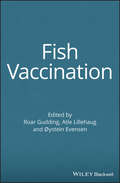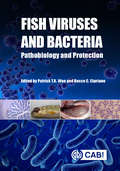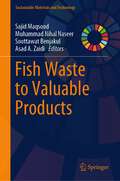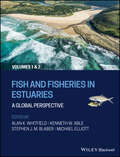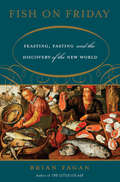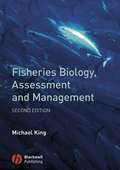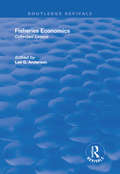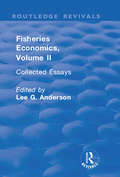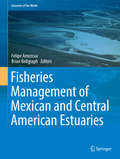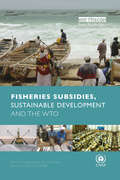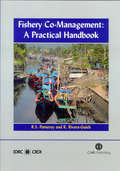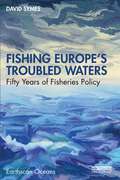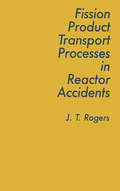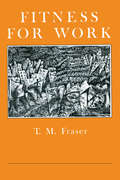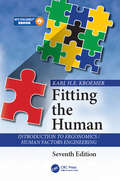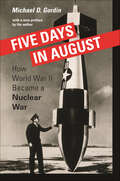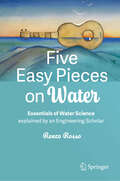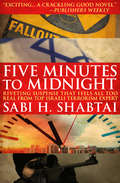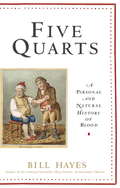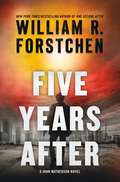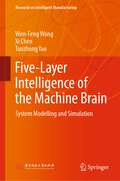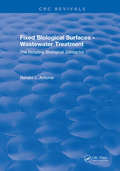- Table View
- List View
Fish Vaccination
by Atle Lillehaug Roar Gudding Øystein EvensenFish farming, in seawater and in freshwater, in cages, tanks or ponds, makes an ever-increasing and significant contribution to the production of aquatic food in many regions of the world. During the last few decades there has been significant progress and expansion in the aquaculture sector, characterized by intensified production and the exploitation of many new species. Aquaculture must be a sustainable bio-production, environmentally as well as economically. Disease prevention in order to reduce losses, and the use of antimicrobials is crucial in this perspective. Vaccination has, in a few years, become the most important method for disease prevention in aquaculture, and effective prophylaxis based on stimulation of the immune system of the fish is essential for further development of the industry. This book provides general information about disease prevention in fish by vaccination, as well as specific descriptions of the correct use of vaccines against the most important bacterial and viral infectious diseases of aquatic animals. The book is written by some of the world’s leading experts in the subject, drawn from many countries where aquaculture is a significant and expanding part of the economy. Fish Vaccination is an encyclopedia of fish vaccinology for every present and future aquaculturist. Professionals in the aquaculture sector, including fish veterinarians and fish biologists, within the industry, in scientific institutions and regulatory authorities will all find a huge wealth of commercially important knowledge within this book. Libraries in all universities where aquaculture, biological and veterinary sciences are studied and taught should have copies of this important book on their shelves.
Fish Viruses and Bacteria: Pathobiology and Protection
by Richard Whittington Robert Davies Associate Professor Arun Dhar Andrew Orry F C Allnutt Dr Scott LaPatra Dr Jo-Ann Leong Dr Gael Kurath Dr John S Lumsden Dr Paul Hick Dr Ellen Ariel Dr Mamoru Yoshimizu Dr Hisae Kasai Dr Yoshihiro Sakoda Dr Nanako Sano Dr Motohiko Sano Dr Knut Falk Dr Maria Aamelfot Dr Peter Dixon Dr David Stone Dr Lester H. Khoo Dr Rodman G. Getchell Dr Geoffrey H. Groocock Dr Keith Way Dr Anna Toffan Dr Yasuhiko Kawato Dr Kuttichantran Subramaniam Dr Kazuhiro Nakajima Dr Thomas Waltzek Dr Marius Karlsen Dr Renate Johansen Dr Bjarnheidur K. Gudmundsdottir Dr Bryndis Bjornsdottir Dr Larry A. Hanson Dr Matt J. Griffin Terence Greenway David J. Wise Thomas P. Loch Mohamed Faisal Esteban M. Soto David T. Gauthier Martha W. Rhodes John P. Hawke Jerri Bartholomew Kristen D. Arkush Diane G. Elliott Craig A. Shoemaker De-Hai Xu Alicia E. Toranzo Beatriz Magariños Ruben Avendaño-Herrera Timothy J. Welch David P. Marancik Christopher M. Good Michael OrmsbyTaking a disease-based approach, Fish Viruses and Bacteria: Pathobiology and Protection focuses on the pathobiology of and protective strategies against the most common, major microbial pathogens of economically important marine and freshwater fish. The book covers well-studied, notifiable piscine viruses and bacteria, including new and emerging diseases which can become huge threats to local fish populations in new geographical regions if transported there via infected fish or eggs. A concise but thorough reference work, this book: - Covers key viral and bacterial diseases of notable fish species; - Reviews major well-established piscine pathogens as well as new, emerging and notifiable diseases; and - Contains the most up-to-date research contributed by a team of over fifty world experts. An invaluable bench book for fish health consultants, veterinarians and all those wanting instant access to information, this book is also a useful textbook for students specializing in fish health and research scientists initiating fish disease research programmes.
Fish Waste to Valuable Products (Sustainable Materials and Technology)
by Soottawat Benjakul Sajid Maqsood Asad A. Zaidi Muhammad Nihal NaseerThis book provides a comprehensive overview of recent developments to valorize fish waste as a source of useful products. In the first few chapters, an introductory section unearths global fish waste production, its detrimental effects and its role in the circular economy. The next section of the book discusses recent applications of fish waste and by-products utilization for the production of useful products such as fertilizers, biogas, biodiesel, fish sauce, enzymes and many more. This book will serve as an important source of recent research developments and applications of fish waste generated at different stages of fish processing. This book will also act as an important reference to the research group conducting research on fish and fish by-product utilization and valorization.
Fish and Fisheries in Estuaries: A Global Perspective
by Michael Elliott Kenneth W. Able Alan K. Whitfield Stephen J.M. BlaberFish and Fisheries in Estuaries: A Global Perspective brings together the current state of knowledge of estuarine fish in one inclusive work. Featuring contributions by more than fifty internationally-recognized researchers and estuarine ichthyological specialists, this landmark resource covers fish assemblages and functional groups, recruitment and production in estuaries, feeding ecology and trophic dynamics, fisheries and the conservation of estuarine fish, and much more. Thirteen in-depth chapters and two method appendices examine major aspects of fish and fisheries in estuaries throughout the world. The text describes the biology of estuarine fish and their connections with estuarine and adjacent marine and freshwater ecosystems, as well as examining the ways human industrialization and global events such as climate change are impacting both native and non-native species. Topics include habitat diversity, fish foraging behavior, ecological engineering tools and models, hazards and risks to estuarine fish and fisheries, and estuarine environmental health. Offering detailed information on the biology and ecology of estuarine fish and fisheries, this authoritative reference: Explores current approaches and future research directions aimed at achieving a balance between exploitation and conservation of estuarine fishes Discusses environmental quality objectives and sustainable management of estuary fisheries Addresses the impacts of increased human use of resources such as food, space, and water to estuarine fish and fisheries Features numerous international case studies of management of fisheries, threatened species, estuarine rehabilitation, reproduction and ontogeny, and others Covers study and sampling methods, field equipment, and data processing, analysis, and interpretation Fish and Fisheries in Estuaries: A Global Perspective is an indispensable tool and reference point for fish biologists, fisheries scientists, ecologists and environmental scientists, aquatic ecologists, conservation biologists, estuarine managers and advanced students and instructors in fish biology and fisheries programs.
Fish and Fishery Products Analysis: A Theoretical and Practical Perspective
by Maya Raman Saleena Mathew Manjusha Kalarikkathara Parameswaran Dhanya Pulikkottil RajanThis novel and informative book discusses the various aspects of seafood quality. The book is divided into 7 broad sections, each tackling a different aspect. The first section covers the general aspects relevant to the nutritional quality of the fish and the various extraction protocols for macro-/ micro-nutrients. The second section provides insights into handling and the principles of thermal and non-thermal processing techniques for commercially important fishery products. The quality standards and safety concerns in the seafood industry and consumption are discussed in this section. The freshness indices of the processed products including biochemical, microbiological and toxicological characteristics are also included. The third section discusses the physico-chemical characteristics and quality parameters of potable water/ ice. The fourth section includes the quality assessment of various toxicants related to seafood products. The fifth section deals with the specific aspects such as principle, instrument and procedures of conventional and novel analytical instruments relevant to the seafood industry. The sixth section deals with the seafood waste management including solid and liquid seafood wastes. Presently, there is a great awareness regarding environmental sustainable processing/ preservation techniques. The final chapter discusses the bioactive compounds from under-utilized marine sources showing pharmaceutical/ nutraceutical applications.
Fish on Friday: Feasting, Fasting, and the Discovery of the New World
by Brian M. FaganWhat gave Christopher Columbus the confidence in 1492 to set out across the Atlantic Ocean? Fish on Friday tells the story of the discovery of America as a product of the long sweep of history: the spread of Christianity and the radical cultural changes it brought to Europe, the interaction of economic necessity with a changing climate, and generations of unknown fishermen who explored the North Atlantic in the centuries before Columbus. A fascinating and multifaceted book, Fish on Friday will intrigue everyone who wonders how the vast forces of climate, culture, and technology conspire to create the history we know.
Fisheries Biology, Assessment and Management
by Michael KingThis excellent second edition of Fisheries Biology, Assessment and Management, has been fully updated and expanded, providing a book which is an essential purchase for students and scientists studying, working or researching in fisheries and aquatic sciences.In the same way that excessive hunting on land has threatened terrestrial species, excessive fishing in the sea has reduced stocks of marine species to dangerously low levels. In addition, the ecosystems that support coastal marine species are threatened by habitat destruction, development and pollution. Open access policies and subsidised fishing are placing seafood in danger of becoming a scarce and very expensive commodity for which there is an insatiable demand.Positive trends include actions being taken to decrease the incidental catches of non-target species, consumer preferences for seafood from sustainable fisheries, and the establishment of no-take areas that provide refuges for marine species. But there is an urgent need to do more.Because there is an increasing recognition of the need to manage ecosystems as well as fish stocks, this second edition of this bestselling text book includes an additional chapter on marine ecology. Chapters on parameter estimation and stock assessment now include step-by-step instructions on building computer spreadsheet models, including simulations with random variations that realistically emulate the vagaries of nature. Sections on ecosystem management, co-management, community-based management and marine protected areas have been expanded to match the increased interest in these areas.Containing many worked examples, computer programs and numerous high quality illustrations, Fisheries Biology, Assessment and Management, second edition, is a comprehensive and essential text for students worldwide studying fisheries, fish biology, aquatic and biological sciences. As well as serving as a core text for students, the book is a superb reference for fisheries and aquatic researchers, scientists and managers across the globe, in both temperate and tropical regions. Libraries in all universities where fish biology, fisheries, aquatic sciences and biological sciences are studied and taught will need copies of this most useful new edition on their shelves.Supplementary material is available at: www.blackwellpublishing.com/king
Fisheries Economics, Volume I: Collected Essays (Routledge Revivals)
by Lee G. AndersonThis title was first published in 2002: This important collection of international research on fisheries economics offers a comprehensive source of contemporary research on key topics in the field, as well as presenting the history of how the economic theory of fisheries exploitation has developed. Bringing into focus a wide range of inquiry, this volume concentrates most particularly on the traditional economic problem of optimal resource allocation. Individual papers examine fundamental issues including, the lack of efficiency of open access and the specification of exactly what dynamic efficiency entails. Fisheries Economics is an invaluable research reference collection for the libraries of academic and other professional economists, as well as an indispensable resource for those studying across the fields of natural resources, fisheries economics and particularly fisheries management.
Fisheries Economics, Volume II: Collected Essays (Routledge Revivals)
by Lee G. AndersonThis title was first published in 2002: This important collection of international research on fisheries economics offers a comprehensive source of contemporary research on key topics in the field, as well as presenting the history of how the economic theory of fisheries exploitation has developed. Bringing into focus a wide range of inquiry, this second volume concentrates on extensions, analysis of management agencies and applications. Individual papers examine fundamental issues including, multispecies models, international utilization and recreational fisheries. Fisheries Economics is an invaluable research reference collection for the libraries of academic and other professional economists, as well as an indispensable resource for those studying across the fields of natural resources, fisheries economics and particularly fisheries management.
Fisheries Management of Mexican and Central American Estuaries
by Felipe Amezcua Brian BellgraphThe tropical estuarine systems of Mexico and Central America are an important part of the region´s coastlines; for example Mexico alone possesses more than 770 thousand hectares of mangroves, as well as the largest estuarine mangrove complex on the American Pacific (Marismas Nacionales), yet is one of the poorest studied areas in the world. This is the first book that deals extensively with fisheries management issues in this region from physical-chemistry, ecological and socioeconomic views, providing an understanding on the function and the effects of human activities on these areas, with works undertaken by local scientist.
Fisheries Subsidies, Sustainable Development and the WTO
by Anja Von MoltkeThe fisheries sector is in crisis. Inappropriate subsidies to the fishing industry are a key factor responsible for worldwide fisheries depletion, overcapitalization and ecosystem degradation. There is an urgent need for an international mechanism to promote the appropriate restructuring of fisheries subsidies in order to create a more sustainable industry. In recent years the leading international forum charged with providing such a mechanism has been the World Trade Organization (WTO). This book explains why and how the reform of fisheries subsidies has become one of the most concrete and potentially successful international efforts to achieve global environmental, economic and developmental policy coherence. It describes the history and current status of the discussions at the WTO, drawing on UNEP's key documents and reflecting on the major issues. Accompanying the book is a CD-Rom containing full-text versions of the most important source material used in the publication. The book is aimed at a broad stakeholder audience, including policymakers in the fields of trade, fisheries, environmental economics and international environmental governance, as well as academics and others looking for an overview of the fisheries subsidies issue and an introduction to its technical components. Published with the United Nations Environment Programme (UNEP)
Fishery Co-management: A Practical Handbook
by Rebecca Rivera-Guieb Robert S. PomeroyFishery co-management refers to an approach that recognizes fishers' participation, local stewardship, and shared decision-making in the management of fisheries. Pomeroy (agricultural resource economics, U. of Connecticut, US) and Rivera-Guieb (independent consultant and board member, Coastal Community Resources and Livelihoods Development Inc., Philippines) present a handbook that lays out the planning and implementation processes of establishing small-scale fishery co- management in developing countries. Addressing all actors who may be involved in co-management, they provide chapters on community entry and integration; research and participatory research; environmental education, capacity development, and social communication; community organizing; co-management plan and agreement; conflict management; plan implementation; and post-implementation. Annotation ©2006 Book News, Inc., Portland, OR (booknews.com)
Fishes of the Sea of Japan and the Adjacent Areas of the Sea of Okhotsk and the Yellow Sea
by G.U. LindbergThis part completes the review of the largest and economically richest order of fishes, Perciformes, begun in Part 3. It includes 12 suborders with keys and brief descriptions to 230 species, and information on their ecology and distribution.
Fishing Europe's Troubled Waters: Fifty Years of Fisheries Policy (Earthscan Oceans)
by David SymesSpanning the last 50 years of fisheries policy in Europe, this book is the parting contribution and career-spanning reflection from one of Europe’s most renowned social scientists working in the field of fisheries management and policy. The last 50 years have without doubt been the most turbulent years in the history of North Atlantic fisheries – a turbulence brought about by the actions of fishers, scientists and above all politicians. It is a period of change that sees a radical redrawing of the political geography of fisheries, globalisation of trade, the development of fisheries management towards increasingly restrictive regulation, and declining fish stocks. The book explains why the bold but deeply flawed Common Fisheries Policy persistently failed to deliver its basic goal of sustainable fisheries. The spotlight falls on the monolithic, highly centralised, command and control nature of the Policy that strives to apply a universal ‘one size fits all’ approach, thus creating a governing system wholly unsuited to the system to be governed, out of kilter with preferred models of governance, and disconnected from the practical realities of fishing as a livelihood in a challenging environment. A final section on Brexit focuses on its halting progress from concept to reality, the implications for the fisheries sector and the fateful final negotiations with the EU over the fisheries question. Seeking to explain why the anticipated benefits for the UK industry failed to materialise, attention is drawn to the misplaced political hubris over regaining ‘sovereignty’ in areas like the North Sea. This book will be essential reading for students, scholars, professionals and policymakers working on fisheries, marine governance, natural resource management, environmental policy and the European Project.
Fission Product Processes In Reactor Accidents
by J. T. RogersThe Three Mile Island and Chernobyl nuclear incidents emphasized the need for the world-wide nuclear community to cooperate further and exchange the results of research in this field in the most open and effective manner. Recognizing the roles of heat and mass transfer in all aspects of fission-product behavior in sever reactor accidents, the Executive Committee of the International Centre for Heat and Mass Transfer organized a Seminar on Fission Product Transport Processes in Reactor Accidents. This book contains the eleven of the lectures and all the papers presented at the seminar along with four invited papers that were not presented and a summary of the closing session.
Fitness For Work: The Role Of Physical Demands Analysis And Physical Capacity Assessment
by T. M. FraserOffers an occupational ergonomic analysis of medical selection procedures for disabled and able-bodied labour-market entrants. The book re-examines the concept of fitness for work and emphasizes humanitarian and legislative factors.
Fitting the Human: Introduction to Ergonomics / Human Factors Engineering, Seventh Edition
by Karl H.E. KroemerThis new edition undergraduate introductory textbook follows the motto of the previous versions: "Solid information, easy-to-read, easy to understand, easy to apply." The aim remains the same: "Human engineering" workplaces, tools, machinery, computers, lighting, shiftwork, work demands, the environment, officers, vehicles, the home – and everything else that we can design to fit the human. The new edition is up-to-date in content and language, in data and illustrations. Like previous versions, this book is for students and professionals in engineering, design, architecture, safety and management and to everybody else who wants to make work safe, efficient, satisfying, and even enjoyable.
Fitting the Human: Introduction to Ergonomics/Human Factors Engineering, Eighth Edition
by Katrin Kroemer ElbertThe aim of this book is to provide “human engineering” for workplaces, tools, machinery, computers, shift work, lighting, sound, climate, work demands, offices, vehicles, healthcare, and the home – and everything else that we can produce – to suit the human body and mind. Now being published in its eighth edition, Fitting the Human focuses on the primary ergonomic task of accommodating the human with the appropriate selection of equipment and tools, work requirements and procedures, physical and social conditions at work, and working hours and shift arrangements.This book provides the ergonomic information needed for the user-friendly design of tasks, equipment, and workplaces. It follows the successful format of previous editions, with updated information and practical guidelines that augment the previous information. It offers refreshed information on ergonomic design for the home and workplace, contemporary ways of working, healthcare and medicine, and artificial intelligence and autonomy. This text also recognizes that cultural differences in living and working vary around the world, so additional insights are offered into ergonomics in global cultures and regions. This title will help the reader understand how to plan and design an overall system and its details to fit the human.Published under the mantra of “solid information, easy to read, easy to understand, easy to apply,” Fitting the Human is written for students and professionals in ergonomics, human factors, product and work design, safety, architecture, management, and all fields of engineering.
Five Days in August: How World War II Became a Nuclear War
by Michael D. GordinMost Americans believe that the Second World War ended because the two atomic bombs dropped on Japan forced it to surrender. Five Days in August boldly presents a different interpretation: that the military did not clearly understand the atomic bomb's revolutionary strategic potential, that the Allies were almost as stunned by the surrender as the Japanese were by the attack, and that not only had experts planned and fully anticipated the need for a third bomb, they were skeptical about whether the atomic bomb would work at all. With these ideas, Michael Gordin reorients the historical and contemporary conversation about the A-bomb and World War II.Five Days in August explores these and countless other legacies of the atomic bomb in a glaring new light. Daring and iconoclastic, it will result in far-reaching discussions about the significance of the A-bomb, about World War II, and about the moral issues they have spawned.
Five Easy Pieces on Water: Essentials of Water Science explained by an Engineering Scholar
by Renzo RossoWater is the essential substance for life on Earth. The natural patrimony of all living beings and the material and cultural heritage, a common good, a shared resource, a treasure trove of humanity. The nature of water, water at rest and in motion, the water cycle and its management are addressed here in a multidimensional, comprehensive and transdisciplinary approach. The book focuses on water without complying with any disciplinary approach: philosophical, historical, physical and mathematical issues are merged with traditional hydrochemistry, hydrostatics, hydrodynamics and hydrology to provide an overview of basic knowledge on Earth’s water. These five lectures can be delivered to any undergraduate STEM student to introduce them a valuable, basic, multidisciplinary knowledge on water. Non-specialists will find here an insight of water made as simple as possible, but not simpler than required
Five Minutes to Midnight
by Sabi H. ShabtaiOriginally published in 1980, Five Minutes to Midnight remains of great interest as a prophetic and frightening predictive vision of the threat of nuclear terrorism.As American Independence Day approaches, many millions are planning a celebratory holiday while one radical, Carlos the Jackal, leader of the dreaded Terror International, planner of the Entebbe highjacking and the massacre at the Munich Olympics, has plans to raise the level of terror to new heights while bringing the threat home to the U.S. with a stolen nuclear weapon.Standing in his way is Sam Sartain, a member of an elite counterintelligence team, who has long pursued Carlos and has learned to analyze the twisted mind and plans of a mass killer. As he follows a series of deadly leads that range from the University campus in Berkeley, California to a prison in Berlin, he must race against time to prevent a colossal act of destructive madness in Washington, DC itself.
Five Quarts: A Personal and Natural History of Blood
by Bill Hayes"We're born in blood. Our family histories are contained in it, our bodies nourished by it daily. Five quarts run through each of us, along some sixty thousand miles of arteries, veins, and capillaries."-from Five Quarts. In the national bestseller Sleep Demons, Bill Hayes took us on a trailblazing trip through the night country of insomnia. Now he is our guide on a whirlwind journey through history, literature, mythology, and science by means of the great red river that runs five quarts strong through our bodies. Profusely illustrated, the journey stretches from ancient Rome, where gladiators drank the blood of vanquished foes to gain strength and courage, to modern-day laboratories, where high-tech machines test blood for diseases and dedicated scientists search for elusive cures. Along the way, there will be world-changing triumphs: William Harvey's discovery of the circulation of the blood; Antoni van Leeuwenhoek's advances in making the invisible world visible in the early days of the microscope; Dr. Paul Ehrlich's Nobel-Prize-winning work in immunology; Dr. Jay Levy's codiscovery of the virus that causes AIDS. Yet there will also be ignorance and tragedy: the widespread practice of bloodletting via incision and the use of leeches, which harmed more than it healed; the introduction of hemophilia into the genetic pool of nineteenth-century European royalty thanks to the dynastic ambitions of Queen Victoria; the alleged spread of contaminated blood through a phlebotomist's negligence in modern-day California. This is also a personal voyage, in which Hayes recounts the impact of the vital fluid in his daily life, from growing up in a household of five sisters and their monthly cycles, to coming out as a gay man during the explosive early days of the AIDS epidemic in San Francisco, to his enduring partnership with an HIV-positive man. As much a biography of blood as it is a memoir of how this rich substance has shaped one man's life, Five Quarts is by turns whimsical and provocative, informative and moving. It will get under your skin.
Five Years After: A John Matherson Novel (A John Matherson Novel #4)
by William R. ForstchenFrom William R. Forstchen, the New York Times bestselling author of the One Second After series, comes Five Years After, a near-future thriller where John Matherson must contend with new threats to the fragile civilization that he helped rebuild.Five years after The Final Day, the Republic of New America has all but collapsed into regional powers and the world at large is struggling to remain stable as regional conflicts ravage the post EMP landscape. After several years attempting to lead a quiet life, John Matherson receives the news that the President is dying from a possible assassination attempt, and is asked to step in to negotiate with what appears to be a new military power hidden in the wreckage of the world.Pulled back into the fray, John struggles to hold the tottering Republic together. Facing threats on multiple fronts, he races against time to stop another EMP attack on the former United States and China, putting years of progress at risk. With so much of his work under threat, John must find the strength within to start over, so that he can save the country and the people that he holds dear from even greater calamity.At the Publisher's request, this title is being sold without Digital Rights Management Software (DRM) applied.
Five-Layer Intelligence of the Machine Brain: System Modelling and Simulation (Research on Intelligent Manufacturing)
by Xi Chen Wen-Feng Wang Tuozhong YaoThis book intends to report the new results of the efforts on the study of Layered Intelligence of the Machine Brain (LIMB). The book collects novel research ideas in LIMB and summarizes the current machine intelligence level as “five layer intelligence”- environments sensing, active learning, cognitive computing, intelligent decision making and automatized execution. The book is likely to be of interest to university researchers, R&D engineers and graduate students in computer science and electronics who wish to learn the core principles, methods, algorithms, and applications of LIMB.
Fixed Biological Surfaces - Wastewater Treatment: The Rotating Biological Contactor
by Ronald L. AntonieOur objective in this book and in subsequent volumes of the Uniscience Series on Water Pollution Control Technology, is to provide a reference manual for design engineers, planners, and managers in industry and government. This is particularly important in the present critical period for implementation of water pollution controls.
